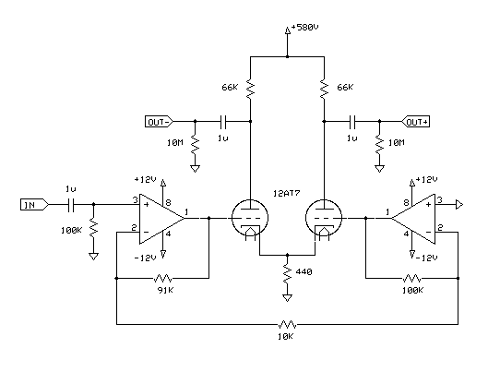jcx
Headphoneus Supremus
- Joined
- Jul 24, 2002
- Posts
- 2,371
- Likes
- 371
the Tube Cad articles on SRPP do mention padding the cathode with additional R, there is a continuum from ccs to "optimum push-pull" to "mu follower" and the articles describe SS versions as "SRPP derived" - clearly there's a strong similarity in operating principles - but it does seem like "SRPP" label is pushing the wrong buttons for some of you
http://www.tubecad.com/2009/09/blog0171.htm
with depletion MOSFET having high gm R padding is needed to get the "optimum" "push-pull" relation at a specified (low) current - looking at the circuit as a modulating current source is useful - "impedance multiplier in the blog
as I pointed out above a possible use of the depletion mode MOSFET is to cascode another current regulator circuit - Walt Jung audioXpress ccs articles shows some options - should give circuit designers some ideas
tapping the current sense resistor to get the push-pull current modulation "impedance multiplication" is applicable to several of the ccs circuits, the stability and TC of the set current, accuracy of push-pull matching can be improved, made nearly independent of the depletion cascode Vth
while I haven't measured my test circuit that carefully - sims with a square law gm model extracted from real parts measurements show the modulating current source simply looks like the load Z has been reduced by 1/2 to beyond 1 MHz
and I don't see the justification for such blunt dismissals of a output stage circuit on grounds of its "sound" - seems too simplistic
if a circuit can drive the load reasonably linearly over the range of expected signal then the rest of the amplifier circuit can control it to varying degrees of accuracy via global and/or local feedback, "distortion compensation" potentially give a range of "sound" - or preferably just be "transparent"
http://www.tubecad.com/2009/09/blog0171.htm
with depletion MOSFET having high gm R padding is needed to get the "optimum" "push-pull" relation at a specified (low) current - looking at the circuit as a modulating current source is useful - "impedance multiplier in the blog
as I pointed out above a possible use of the depletion mode MOSFET is to cascode another current regulator circuit - Walt Jung audioXpress ccs articles shows some options - should give circuit designers some ideas
tapping the current sense resistor to get the push-pull current modulation "impedance multiplication" is applicable to several of the ccs circuits, the stability and TC of the set current, accuracy of push-pull matching can be improved, made nearly independent of the depletion cascode Vth
while I haven't measured my test circuit that carefully - sims with a square law gm model extracted from real parts measurements show the modulating current source simply looks like the load Z has been reduced by 1/2 to beyond 1 MHz
and I don't see the justification for such blunt dismissals of a output stage circuit on grounds of its "sound" - seems too simplistic
if a circuit can drive the load reasonably linearly over the range of expected signal then the rest of the amplifier circuit can control it to varying degrees of accuracy via global and/or local feedback, "distortion compensation" potentially give a range of "sound" - or preferably just be "transparent"





















